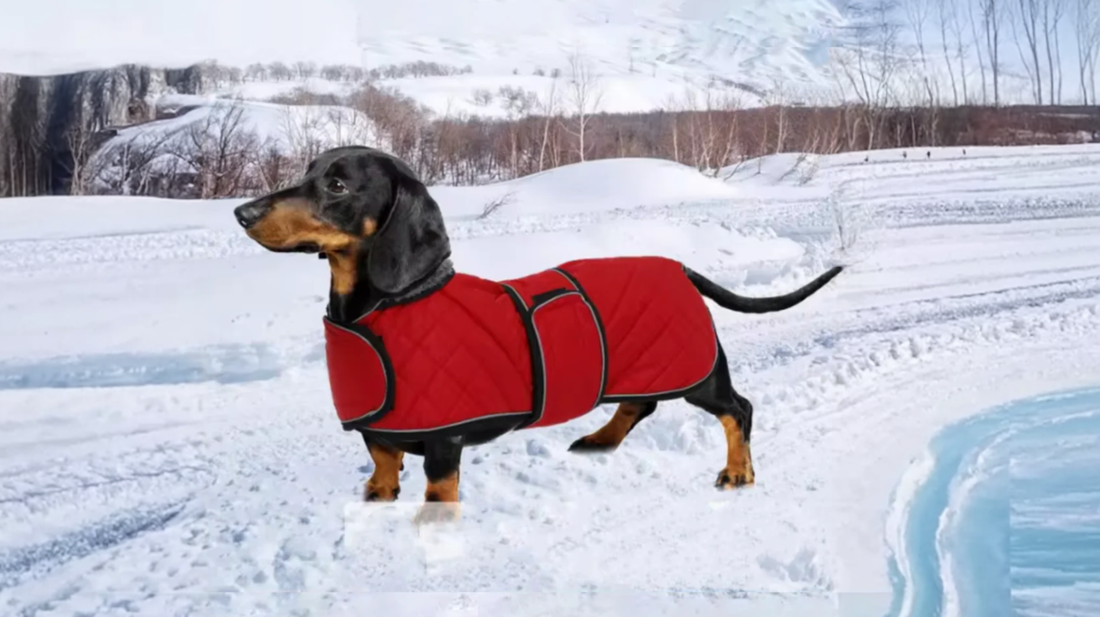
8 Common Outdoor Winter Health Risks for Dachshunds
Compartir
Winter brings special challenges for dogs going outside — and for Dachshunds in particular. Because of their unique body shape (long back, short legs) and often low body fat/fur coverage, they can be more vulnerable than average. Drawing on general winter-outdoor risks and customizing for Dachshunds, here are eight key risks – and how to manage them.
Listen on Spotify
1. Hypothermia & Cold Stress
Just like any dog exposed to cold for too long, Dachshunds can suffer hypothermia: their body temperature drops, they shiver, become lethargic, muscles stiffen, heart and breathing slow. Another severe winter weather condition is hypothermia… when a dog spends plenty of time in the cold, gets wet in a cold climate.
Because Dachshunds have short legs and often low snow clearance or low insulation, they’re more exposed to chilly ground, icy winds, or snow reaching up their belly.
Prevention tips:
- Limit outdoor time when it’s very cold, especially if the dog hasn’t got a thick coat or is older/smaller.
- Dress your Doxie in a proper winter jacket (see product suggestions below) that covers the chest, belly and back.
- Avoid letting them stay wet from snow or slush – dry them promptly.
- Watch for signs: shivering, looking for shelter, whining, slowing down, reluctance to walk.
Product recommendation:
A great option: the Premium Fleece Dachshund Coat — it offers padded fleece lining, adjustable straps for fit, and helps defend against chilly winds.
2. Frostbite on Extremities & Underside
In very cold or icy conditions, small dogs with low clearance and short limbs may risk frostbite — especially on their paws, tail tip, ears, and even belly if pressed to cold ground.
Why Dachshunds are especially at risk:
- Their bellies may lie close to the cold ground or snow.
- Their short legs may expose paws to ice, salt, or chemicals more.
- Their tail tips may drag or come into contact with cold surfaces.
Prevention tips:
- Use booties if you expect snow/ice; check paw pads regularly.
- After walks, wipe and dry underbelly, legs and paws.
- Avoid letting them lie directly on cold ground for long.
- Use a jacket that covers the belly and helps insulate.
Product recommendation:
Consider the Dachshund Quilted Warm Winter Coat — water-resistant & wind-proof outer, fleece lining, and tailored for low-body Dachshunds, which helps protect underside from cold ground contact.
3. Slippery Surfaces and Back/Spine Strain
Winter often means ice, snow, slush – slippery surfaces. For Dachshunds, slippery ground is especially dangerous: their short legs + long backs mean that a slip or fall can lead to spinal strain or the dreaded intervertebral disc disease (IVDD) risk, which this breed is predisposed to. Wikipedia+1
Prevention tips:
- Keep walks on surfaces with traction (avoid untreated icy sidewalks).
- Consider paw grips or dog boots with tread for extra traction.
- Shorten leash walks in ice conditions so they’re less likely to run/sidestep sharply.
- Keep your Dachshund at a healthy weight to reduce spinal load.
Product suggestion:
While doxie.us may not currently list specialized traction boots (based on my search), pairing the Dachshund winter jacket above with a good harness can help control them and reduce sudden strain. e.g., you might pair with a snug no-pull dachshund harness offered on the site. Dachshund Shop
4. Wetness, Slush & Salt Chemicals
Snow and slush often have salt or de-icers which can irritate paw pads, damage skin, and when wet, increase heat loss. Dachshunds, the belly and chest areas are close to the ground and more likely to get wet.
Prevention tips:
- Use a waterproof or water-resistant coat with belly coverage.
- After walks, rinse paws/underside if salted sidewalks were used.
- Provide dry warm ground/bed indoors for them after being outside.
- Consider paw balm or protective pad wax.
Product recommendation:
The FrostGuard Winter Waterproof Dachshund Harness Jacket is designed for cold winter walks: thick felt insulation + waterproof outer + integrated harness. This helps keep them dry, warm and safe on salted/slushy surfaces.
5. Low Light, Visibility & Reduced Daylight Risks
Winter often means shorter days, early dusk, and often gloomy skies. Dogs can become less visible outdoors. Dachshunds, their size makes them less visible, especially against snow/ice backgrounds.
Prevention tips:
- Choose jackets or coats with reflective strips or bright colours.
- Walk during daylight hours if possible; avoid very late evening in low visibility.
- Use leash and maybe a lighted collar or harness for additional visibility.
- Be extra cautious near roads with snow banks interrupting sight lines.
Product recommendation:
Again, the FrostGuard jacket (above) includes reflective parts as described. The padded fleece winter coat also mentions safety features. Having such gear improves visibility.
6. Joint & Back Pain from Cold + Long Body Strain
Cold weather causes muscles to stiffen and joints to ache more easily. In a breed like the Dachshund with a long back/spinal predisposition (IVDD risk) and sometimes shortened legs, this is especially important. Cold ground is hard on joints and muscles.
Prevention tips:
- Limit overly vigorous outdoor play in freezing temps.
- Use warm bedding indoors; ensure they have a raised or padded bed not cold tile or concrete
- After walks, allow them a warm period of rest and maybe gentle warm-up/stretch indoors.
- Dress them warmly so their muscles stay warm during outdoor time.
Product suggestion:
While primarily outerwear, the Dachshund Quilted Warm Winter Coat first product above) helps keep core and back warm so muscles stay more limber. Also consider adding a warm indoor bed (not necessarily from doxie.us but worth recommending) to keep joints comfy.
7. Shorter Walks and Exercise Changes
In winter, walks may be shorter due to weather or daylight. But for Dachshunds, which need consistent moderate exercise (to keep weight and spine safe), this change can mean they get less movement – and maybe gain weight, which increases strain. Also snowy/icy terrain may mean they exert more energy.
Prevention tips:
- Monitor walk duration: even if outdoors time is less, try to maintain consistent frequency.
- Use indoor play or safe winter-appropriate movement to supplement.
- Keep a close eye on weight, as extra body weight stresses the long back.
- After a shorter walk outdoors, allow indoor movement/stretch to avoid stiffness.
Product suggestion:
Make sure outdoor gear is comfortable so you don’t cut walks short because the dog is cold. The Dachshund Winter Jacket for Ultimate Comfort (Stylish Dachshund Winter Jacket for Ultimate Comfort) can help make outdoor time more tolerable for your doxie, so you can maintain consistent outings.
8. Behavioral Changes Leading to Hidden Risk
When the weather gets bad, many dogs change behaviour: they may whine, try to burrow, go back in early, lie in sheltered spots, shiver, or show reluctance. these behavioural cues might be more subtle (they might still wag tail but be uneasy) and can mask underlying discomfort, cold or joint pain.
Prevention and watch-outs:
- As an owner, pay attention to your dog’s pace, posture, interest level in outdoor time.
- If they suddenly shorten walks, lie down after few minutes, or avoid certain surfaces, it may signal discomfort from cold or joint/back pain.
- Adapt outdoor time accordingly: shorter, warmer, more sheltered.
- Use appropriate gear (jackets, boots) to reduce external stress so behaviour stays normal.
Product suggestion:
To help with comfort and encourage positive outdoor behaviour, the CozyTail Dachshund Winter Coat provides full coverage (neck, chest, back), water-resistant outer, faux-down liner, which can reduce discomfort and help maintain your pup’s enjoyment of outdoor walks.
Final Thoughts and Owner Checklist
Winter doesn’t have to mean your Dachshund stays indoors and misses their walks — but it does mean you need to be proactive. Your long-backed, short-legged friend has specific vulnerabilities (cold exposure, joint/back strain, low visibility, wet/slushy ground) that should shape how you handle outdoor time in cold weather.
Here’s a quick winter walk checklist for your Dachshund:
Dress your Doxie in a well-fitting winter coat covering chest/belly/back.
Consider paw protection / wipe paws after walks.
Choose safe surfaces with good traction; shorten walks if icy.
Use bright/reflective gear and walk in daylight where possible.
After returning, dry your dog thoroughly; provide a warm bed.
Monitor behaviour: no shivering, seeking shelter, reluctance to walk.
Maintain regular exercise schedule; supplement indoors if needed.
Monitor weight and back health (regular check-ups if you have concerns).
Keep outdoor time manageable — multiple shorter walks may be better than one long walk.
Opt for winter gear tailored for Dachshunds’ body shape (long back, low clearance) — standard dog coats may not fit well.
By using the right gear (like the products above) and watching your pup’s cues and environment, your Dachshund can enjoy outdoor time safely even in colder months.
